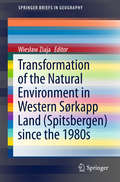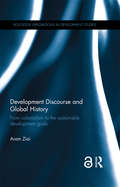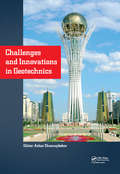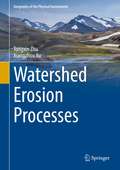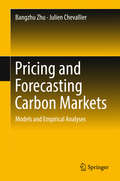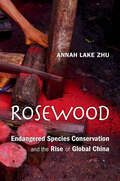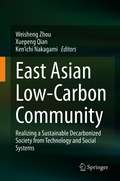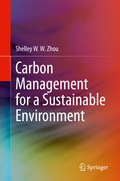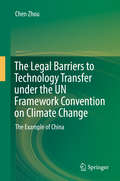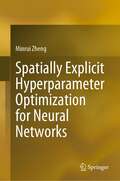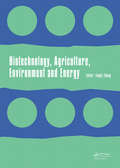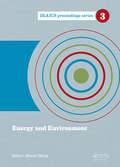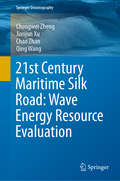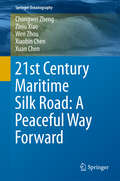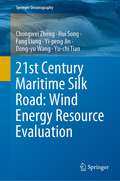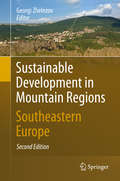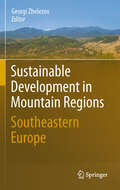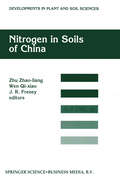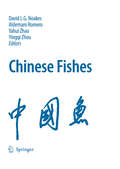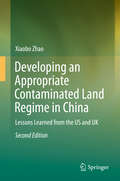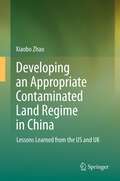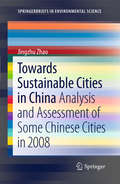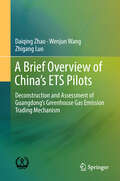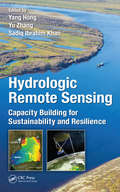- Table View
- List View
Transformation of the natural environment in Western Sørkapp Land (SpringerBriefs in Geography)
by Wiesław ZiajaThis revised edition describes the transformation of the environment and landscape of Western Sørkapp Land based on research data collected by Jagiellonian University scientific expeditions in the period 1980–1986 and in 2008. It also outlines potential directions of the transformation of Western Sørkapp Land.Western Sørkapp Land has been experiencing dramatic natural changes such as glacial recession, coastline retreat, emergence of new landforms and Quaternary deposits, as well as changes in the water drainage and network due to global warming. Western Sørkapp Land is a very remote and diverse region, which is representative of the European Arctic. The establishment of South Spitsbergen National Park has led to a regeneration of the local reindeer herd, which has caused overgrazing of the local tundra resulting in altered plant communities and soil erosion. They have also destroyed numerous bird nests. The transformation of Western Sørkapp Land is set to continue.
Development Discourse and Global History: From colonialism to the sustainable development goals (Routledge Explorations in Development Studies)
by Aram ZiaiThe manner in which people have been talking and writing about ‘development’ and the rules according to which they have done so have evolved over time. Development Discourse and Global History uses the archaeological and genealogical methods of Michel Foucault to trace the origins of development discourse back to late colonialism and notes the significant discontinuities that led to the establishment of a new discourse and its accompanying industry. This book goes on to describe the contestations, appropriations and transformations of the concept. It shows how some of the trends in development discourse since the crisis of the 1980s – the emphasis on participation and ownership, sustainable development and free markets – are incompatible with the original rules and thus lead to serious contradictions. The Eurocentric, authoritarian and depoliticizing elements in development discourse are uncovered, whilst still recognizing its progressive appropriations. The author concludes by analysing the old and new features of development discourse which can be found in the debate on Sustainable Development Goals and discussing the contribution of discourse analysis to development studies. This book is aimed at researchers and students in development studies, global history and discourse analysis as well as an interdisciplinary audience from international relations, political science, sociology, geography, anthropology, language and literary studies.
Development Discourse and Global History: From colonialism to the sustainable development goals (Routledge Explorations in Development Studies)
by Aram ZiaiThe manner in which people have been talking and writing about ‘development’ and the rules according to which they have done so have evolved over time. Development Discourse and Global History uses the archaeological and genealogical methods of Michel Foucault to trace the origins of development discourse back to late colonialism and notes the significant discontinuities that led to the establishment of a new discourse and its accompanying industry. This book goes on to describe the contestations, appropriations and transformations of the concept. It shows how some of the trends in development discourse since the crisis of the 1980s – the emphasis on participation and ownership, sustainable development and free markets – are incompatible with the original rules and thus lead to serious contradictions. The Eurocentric, authoritarian and depoliticizing elements in development discourse are uncovered, whilst still recognizing its progressive appropriations. The author concludes by analysing the old and new features of development discourse which can be found in the debate on Sustainable Development Goals and discussing the contribution of discourse analysis to development studies. This book is aimed at researchers and students in development studies, global history and discourse analysis as well as an interdisciplinary audience from international relations, political science, sociology, geography, anthropology, language and literary studies.
Challenges and Innovations in Geotechnics: Proceedings of the 8th Asian Young Geotechnical Engineers Conference, Astana, Kazakhstan, August 5-7, 2016
by Askar ZhussupbekovChallenges and Innovations in Geotechnics is a collections of papers presented at the Eighth Asian Young Geotechnical Engineering Conference (8AYGEC, Astana, Kazakhstan, 5-7 August 2016), and covers various aspects the areas of soil mechanics and geotechnical engineering. The book contains special and keynote lectures and contributions on a wide range of topics in geotechnical engineering and construction: (1) Laboratory and Field Testing(2) Foundation and Underground Structure(3) Ground Improvement(4) Earthquake and Environment(5) Numerical and Analytical Modeling(6) Advanced Soil Mechanics(7) Historical Sites Challenges and Innovations in Geotechnics was published under the auspices of the ISSMGE TC-305 ‘Geotechnical Infrastructures for Megacities and New Capitals’, and reflects the present and future state of geotechnical engineering. The book will be extremely useful to geoengineers and researchers in the abovementioned areas.
Watershed Erosion Processes (Geography of the Physical Environment)
by Tongxin Zhu Xiangzhou XuThis monograph is a fundamental study of watershed erosion and runoff processes. It utilizes decades of soil erosion data to take a comprehensive and balanced approach in covering various watershed erosion processes. While there are many works on soil erosion and conservation, this book fills the gaps in previously published research by focusing more on mass movement, gully erosion, soil piping/tunnel erosion, and the spatial interactions of different erosion processes. Additionally, the book examines erosion processes in extreme rainfall events, something typically absent in short-term studies but discussed in detail here as the book draws on 60 years of research and observations, including 30 years of the author's own investigations of erosion under a wide range of rainfall conditions. The book is divided into 3 parts, and is intended for soil erosion researchers and practitioners, and postgraduate students studying soil erosion and water conservation. Part 1 opens with a comprehensive and critical review of existing literature on soil erosion processes, discusses this book's place among existing literature, and examines the major erosion processes (rainwash, gully erosion, tunnel erosion, and mass movements) including their controlling factors and mechanisms. Part 2 explores the spatial interactions of these different erosion processes to provide a prerequisite for effective design of comprehensive soil erosion control measures in a watershed. Part 3 evaluates the relative significance of these erosion processes in sediment production, the effectiveness of comprehensive soil and water conservation programs, and the applications of watershed modelling in determining the impact of land-use changes on soil erosion and other ecological processes.
Pricing and Forecasting Carbon Markets: Models and Empirical Analyses
by Bangzhu Zhu Julien ChevallierThis book applies the multidisciplinary approaches of econometrics, statistics, finance and artificial intelligence for pricing and forecasting the carbon market in the context of managerial issues. It explores the related issues of pricing and forecasting the carbon market using theoretical models and empirical analyses, demonstrating how the carbon market, as a policy-based artificial market, is complex and influenced by both the market mechanisms and the external heterogeneous environments. By integrating the features of analytical systems, it offers insights to further our scientific understanding of the pricing mechanism and the variable laws governing the carbon market. Moreover, it lays a foundation for dealing with climate change in China and constructing a national carbon market there. Ultimately, it actively contributes to the energy saving and CO2 emission reduction promoted by the carbon market.The carbon market, represented by the European Union Emissions Trading System (EU ETS), is a cost-effective measure for tackling climate change. Furthermore, pricing and forecasting carbon market has been one of the research focuses in the fields of energy and climate change. As a policy tool of the trading mechanism, the carbon market offers a great institutional innovation for coping with climate change. Due to its multiple advantages including saving costs and environment protection, and political feasibility, more and more countries including China have applied the carbon market for carbon dioxide (CO2) emission reduction. Accurately understanding the pricing mechanism and mastering the fluctuating law of carbon market is essential to build a national carbon market for China.
Rosewood: Endangered Species Conservation and the Rise of Global China
by Annah Lake ZhuA riveting study of the booming rosewood trade between China and Madagascar uncovers an alternative approach to environmentalism that disrupts Western models. Rosewood is the world’s most trafficked endangered species by value, accounting for larger outlays than ivory, rhino horn, and big cats put together. Nearly all rosewood logs are sent to China, fueling a $26 billion market for classically styled furniture. Vast expeditions across Asia and Africa search for the majestic timber, and legions of Chinese ships sail for Madagascar, where rosewood is purchased straight from the forest. The international response has been to interdict the trade, but in this incisive account Annah Lake Zhu suggests that environmentalists have misunderstood both the intent and the effect of China’s appetite for rosewood, causing social and ecological damage in the process. For one thing, Chinese consumers are understandably seeking to reclaim their cultural heritage, restoring a centuries-old tradition of home furnishing that the Cultural Revolution had condemned. In addition, Chinese firms are investing in environmental preservation. Far from simply exploiting the tree, businesses are carefully managing valuable forests and experimenting with extensive new plantings. This sustainable-use paradigm differs dramatically from the conservation norms preferred by Western-dominated NGOs, whose trade bans have prompted speculation and high prices, even encouraging criminal activity. Meanwhile, attempts to arm conservation task forces—militias meant to guard the forests—have backfired. Drawing on years of fieldwork in China and Madagascar, Rosewood upends the pieties of the global aid industry. Zhu offers a rigorous look at what environmentalism and biodiversity protection might look like in a world no longer dominated by the West.
East Asian Low-Carbon Community: Realizing a Sustainable Decarbonized Society from Technology and Social Systems
by Weisheng Zhou Xuepeng Qian Ken’ichi NakagamiThis book presents new vision of regional de-carbonization with concrete scheme design and substantial quantitative demonstration from original interdisciplinary studies. It provides new horizon for not only climate change, environmental conservation but also for international cooperation and peace in East Asia. The chapters introduce diverse low carbon society principles from local to global level with best practices integrating technology evolution and social innovation. While the book is designated for academics and the ultimate goal is to facilitate international climate regime making and environmental cooperation, local government and international organizations (United Nations, World Bank, and others) officers, researchers, international NGO/NPOs, consultants, students (particularly those studying environmental policy studies or international relationships), as well as reporters will find this book useful in broadening their understanding of low-carbon development in East Asia.
Carbon Management for a Sustainable Environment
by Shelley W. ZhouThis textbook presents students with a systematic approach for the quantification and management of greenhouse gas emissions (GHG) and provides best practices for optimal carbon management and quantification. The book begins with an overview of climate change basics and goes on to discuss carbon footprint measurements, carbon management concepts, and concludes by presenting carbon reduction solutions with applications for green buildings, smart transportation, waste management, and carbon trading and offsetting. The author provides practical examples and carbon management models that support innovative reduction solutions and presents a roadmap for the implementation and development of carbon management strategies, making it a useful resource for both upper undergraduate and graduate students as well as practitioners seeking a comprehensive framework to conduct carbon management.
The Legal Barriers to Technology Transfer under the UN Framework Convention on Climate Change: The Example of China
by Chen ZhouThe book discusses climate technology transfer under the UNFCCC framework, and China’s relevant legislation and practices. It first explores theoretical basis of climate change-related technology transfer, with a particular focus on the differences between climate technology transfer and business-as-usual performance. The book then reviews practices of both technology supplier and user, in order to generally identify potential legal barriers and obstacles. Finally, it sheds light on China, providing a comprehensive assessment on barriers that hinder the trans-boundary transfers of low carbon technologies and need to be overcome in future. The issues concerned involve two of the most dynamic areas in current China’s lawmaking progress: environment laws and Intellectual Property laws. The book provides an in-depth analysis on China’s legislation and practices in this regard. At international level, the legal framework of climate technology transfer is examined in a systematic, prudent and constructive manner. On this basis, the book highlights potential commons, consistency and possible coordination between the UNFCCC and the WTO regime. This book is accessible to both Chinese and international environmental law specialists. It appeals to a broad readership, including environmental scientists, economists concerned with China’s intellectual property law, foreign investment law and anyone interested in the topic: how to green intellectual property rights regime for climate technology transfer in the China context.
Spatially Explicit Hyperparameter Optimization for Neural Networks
by Minrui ZhengNeural networks as the commonly used machine learning algorithms, such as artificial neural networks (ANNs) and convolutional neural networks (CNNs), have been extensively used in the GIScience domain to explore the nonlinear and complex geographic phenomena. However, there are a few studies that investigate the parameter settings of neural networks in GIScience. Moreover, the model performance of neural networks often depends on the parameter setting for a given dataset. Meanwhile, adjusting the parameter configuration of neural networks will increase the overall running time. Therefore, an automated approach is necessary for addressing these limitations in current studies. This book proposes an automated spatially explicit hyperparameter optimization approach to identify optimal or near-optimal parameter settings for neural networks in the GIScience field. Also, the approach improves the computing performance at both model and computing levels. This book is written for researchers of the GIScience field as well as social science subjects.
Biotechnology, Agriculture, Environment and Energy: Proceedings of the 2014 International Conference on Biotechnology, Agriculture, Environment and Energy (ICBAEE 2014), May 22-23, 2014, Beijing, China.
by Fangli ZhengThe 2014 International Conference on Biotechnology, Agriculture, Environment and Energy (ICBAEE 2014) was held May 22-23, 2014 in Beijing, China. The objective of ICBAEE 2014 was to provide a platform for researchers, engineers, academics as well as industry professionals from all over the world to present their research results and development act
Energy and Environment: Proceedings of the 2014 International Conference on Energy and Environment (ICEE 2014), June 26-27, Beijing, China
by Dawei ZhengThe 2014 International Conference on Energy and Environment (ICEE 2014) was held June 26-27 in Beijing, China. The objective of ICEE 2014 was to provide a platform for researchers, engineers, academics as well as industry professionals from all over the world to present their research results and development activities in Energy and Environment res
21st Century Maritime Silk Road: Wave Energy Resource Evaluation (Springer Oceanography)
by Chongwei Zheng Jianjun Xu Chao Zhan Qing WangThis book focuses on the evaluation of wave energy in the Maritime Silk Road. Firstly, it compares wave energy and other main energy sources, and then discusses the various disadvantages. It also presents the current research and the difficulties of wave energy evaluation, and systematically analyzes the climatic characteristics of the wave energy, including the temporal–spatial distribution and climatic trend of a series of key factors (e.g. wave power density, availability, richness, stability, energy direction, energy storage). It then describes the design of a short-term forecasting scheme and a long-term projection scheme of wave energy suitable for the Maritime Silk Road, to serve as a plan for the daily operation and long-term development of wave energy. Further, it highlights the wave energy analysis and decision-making in the context of the remote islands and reefs, using Sri Lanka is taken as a case study. Lastly, it presents the first wave energy resource dataset for the Maritime Silk Road.This book is one of a series of publications on the 21st century Maritime Silk Road (shortened as “Maritime Silk Road”) that covers the characteristics of the marine environment and marine new energy, remote islands and reef construction, climate change, early warning of wave disasters, legal escort, marine environment and energy big data construction, contributing to the safe and efficient construction of the Maritime Silk Road. It aims to improve our knowledge of the ocean, and so improve the capacity for marine construction, enhance the viability of remote islands and reefs, ease the energy crisis and protect the ecological environment and improve the quality of life of residents along the Maritime Silk Road, as well as to protect the rights, and interests of the countries and regions participating in the construction of the Maritime Silk Road. This book is a valuable reference resource for decision-makers, researchers, and marine engineers working in the related fields.
21st Century Maritime Silk Road: A Peaceful Way Forward (Springer Oceanography)
by Chongwei Zheng Ziniu Xiao Wen Zhou Xiaobin Chen Xuan ChenThis book focuses on understanding the characteristics of the marine environment; overall characteristic of the marine resources (especially the marine new energy) and their current utilization; important routes, channels, and ports; and the Maritime Silk Road from the perspective of international law. It also discusses the significance and opportunities of the Maritime Silk Road initiative, analyzes the challenges involved in the construction of the Maritime Silk Road and provides corresponding countermeasures. Based on the above research, this book also proposes to construct a comprehensive application platform for the Maritime Silk Road that will be a practical tool for decision-making. This book is one of the series publications on the 21st century Maritime Silk Road (shortened as “Maritime Silk Road”). This series publications cover the characteristics of the marine environment and marine new energy, remote islands and reefs construction, climate change, early warning of wave disasters, legal escort, marine environment and energy big data construction, etc. contributing to the safe and efficient construction of the Maritime Silk Road. It aims to improve our knowledge of the ocean, thus to improve the capacity for marine construction, enhance the viability of remote islands and reefs, ease the energy crisis and protect the ecological environment, improve the quality of life of residents along the Maritime Silk Road, and protect the rights, interests of the countries and regions participating in the construction of the Maritime Silk Road. It will be a valuable reference for decision-makers, researchers, and marine engineers working in the related fields.
21st Century Maritime Silk Road: Wind Energy Resource Evaluation (Springer Oceanography)
by Chongwei Zheng Hui Song Fang Liang Yi-peng Jin Dong-yu Wang Yu-chi TianThis book aims to establish a wind energy evaluation system, to provide scientific reference for site selection, daily operation and long-term planning of wind power generation, thus to make contribution to breaking the shackles of power shortage. Firstly, it presents the advantages and disadvantages of offshore wind power, then further discusses about the status quo and challenges for wind power programs along the Maritime Silk Road and offer suggestions. A wind energy evaluation system was proposed with the Maritime Silk Road as a case study, including climatic features of wind power (temporal-spatial distribution), long-term climatic trend and mechanism, short-term forecast of wind energy, mid- and long-term projection of wind energy, technology of wind energy evaluation on key point or vital region and offshore wind energy dataset construction, to provide systematic and scientific reference for wind power evaluation and utilization.This book is one of the series of publications on 21st century Maritime Silk Road (shortened as “Maritime Silk Road”). It covers the characteristics of the marine environment and marine renewable energy, remote islands and reefs construction, climate change, early warning of wave disasters, legal escort, marine environment and energy big data construction, etc., contributing to the safe and efficient construction of the Maritime Silk Road. It aims to improve our knowledge of the ocean, thus, to improve the capacity for marine construction, enhance the viability of remote islands and reefs, ease the energy crisis and protect the ecological environment, improve the quality of life of residents along the Maritime Silk Road, and protect the rights, interests of the countries and regions participating in the construction of the Maritime Silk Road. It is a valuable reference for decision-makers, researchers, and marine engineers working in the related fields.
Sustainable Development in Mountain Regions: Southeastern Europe
by Georgi ZhelezovThis second edition of the book Sustainable Development of Mountain Regions: Southeastern Europe integrates the scientific results and expertise of the researchers from the countries in Southeastern Europe. The book consists of updated information for the topics observed in first edition and several new chapters with analysis of some problems in the mountain regions of four new for the edition countries in Southeastern European space. The general themes in the book are related to Global problems and mountain regions; Nature resources and landuse in mountain regions; Social, economic and regional problems of mountain regions; Nature protection, conservation and monitoring and Networks and strategies for mountain regions. The key topics for discussion are:Natural recourses and land use in mountain regions.Sustainable social and economic development of the mountain regions. Natural disasters and risk prevention.Spatial modeling and planning. Nature protection, monitoring and conservation.Politics and sustainable practices for development of mountain regions.Transborder and regional cooperation. Mountain regions in Southeastern Europe are characterized by unique landscape and biological diversity and great economic potential. They have function as a living space and provide different groups of ecosystem and landscape services. In social and economic aspects these regions are one of the poorest in Southeastern European countries with unused potential. Human, ecological and economic problems arising in various mountain regions have the same basic characteristics irrespective of the country. Some mountain regions are subject to specific for the conditions of the mountain and country policy for planning, development and mountain population promotion. The general goal is development of whole economy and the efficient management of natural resources and prevention of natural and technological disasters. The mountain regions are one of the most threatened landscape systems in Southeastern Europe. Understanding the importance of the mountain regions and conservation of the natural heritage require scientific and institutional cooperation at all levels.
Sustainable Development in Mountain Regions: Southeastern Europe
by Georgi ZhelezovThe mountain regions in Southeastern Europe are unique natural regions of great beauty and ecological value, and home of the head waters of major rivers. They constitute a major ecological, economic, cultural, recreational and living environment in Europe, shared by numerous cultures and countries. The Southeastern European Mountain Regions are an important reservoir for biodiversity and habitats in Europe. A great number of protected areas – national parks, nature parks, reserves and nature monuments are located in these regions. From a socio-economic point of view the mountain regions are among the poorest areas in the Southeastern European countries, but they have potential for the implementation of successful economic activities. There are opportunities for development of these regions and, in particular, for trans-border integration and co-operation. This book brings together research results from experts from all Balkan countries working on the problems of the mountain regions in Southeastern Europe. The volume focuses on the challenges taking place along the rapid transformation in land use, biodiversity, tourism, nature risk and bio-productivity due to the global changes and particularly due to the local impacts of climate change. The key questions for discussion are:- Biodiversity, nature protection and conservation - Natural disasters and risk management- Social-economical development of the mountain regions- Spatial planning in the development of the mountain regions- Sustainable practices and politics for land use- Transborder co-operation.
Nitrogen in Soils of China (Developments in Plant and Soil Sciences #74)
by Zhu Zhu Zhao-Liang Wen Wen Qi-Xiao J. R. FreneyThe study of soil nitrogen has long been an active field, but it was generally pivoted on agricultural and forestry production, and animal husbandry. With the rapid increase in the use of fertilizer nitrogen, more attention has been paid to the rela tionship between nitrogen management and environmental quality and human of soil nitrogen has become more comprehensive with health. In addition, the study the development of related sciences. The quantitative study of the processes in nitrogen cycling and their interrelationships has been an important part of this project and has attracted the attention of scientists allover the world. Nitrogen is one of the most important nutrients for plant growth and the applica tion of fertilizer nitrogen is playing an important role in agricultural production. The annual consumption of fertilizer nitrogen in the world has reached 70 million tons, and China has an annual consumption of more than 15 million tons and is the largest fertilizer nitrogen consumer in the world. However, the efficiency of nitro gen fertilizer is low and losses are large. It is estimated that nitrogen losses from agriculture in our country can be as high as 40-60% of the nitrogen applied. Some of the lost nitrogen enters the atmosphere and contributes to the greenhouse effect and some enters water bodies to pollute the water.
Chinese Fishes (Developments in Environmental Biology of Fishes #28)
by Yahui Zhao Yingqi Zhou David L. G. Noakes Aldemaro RomeroThis book documents the current state of research by Chinese scientists on fish biology and fisheries and brings together manuscripts by authors from research institutions, universities and government agencies. There are papers on aquaculture, life history, genetics, marine and freshwater biology, conservation, physiology, new species descriptions, and truly amazing hypogean fishes. The information on these remarkable cave species shows how much we have yet to learn from that incredible fauna. There are papers dealing with some of the largest fishes and some of the smallest cave species. There are papers dealing with some of the most traditional forms of aquaculture and others with the most modern molecular techniques. The volume includes papers on critically threatened native fishes as well as the most common food species, such as grass carp (Ctenopharyngodon idella). The information on rare and threatened species shows how China is dealing with their endangered fishes. The information on their carp species will be invaluable to those in other countries who will either take advantage of the productive carp species in aquaculture or try to manage them as invasive species outside China. For the first time we bring together a complete overview of the state of fisheries research in China.
Developing an Appropriate Contaminated Land Regime in China: Lessons Learned from the US and UK
by Xiaobo ZhaoThis book explores the complex package of mechanisms used to identify, record, manage and remediate contaminated land, including the system for allocating liabilities that has been set up by China’s contaminated land law and accompanying administrative decrees and environmental standards. Statutory control of soil or land contamination is a comparatively new phenomenon for Chinese lawmakers and researchers. After more than ten years of preparation, China recently adopted its first nationwide contaminated land law—the Law of the People’s Republic of China on the Prevention and Control of Soil Contamination, which entered into effect in the beginning of 2019. The law deals exclusively with risk management in connection with soil contamination, and the remediation of contaminated land. This book analyzes various facets of how China is managing the risks associated with soil contamination and remediating contaminated sites by means of legislation. Chapters 1 and 2 reveal the current extent of the soil contamination problem in China and the initial policy responses of the country’s central government. In turn, Chapters 3 and 4 address the regulatory frameworks and the latest contaminated land legislation at both the local and national level. Lastly, Chapters 5 through 9 offer concrete recommendations, based on lessons learned in the US and UK, for reforming contaminated land management in China. Overall, the book covers the past, present and future of contaminated land management in China, making it of interest to environmental policymakers, administrators, academics, lawyers and engineers engaged in soil or environmental protection. Further, it offers a source of reliable information for those who want to learn more about China’s environmental legislation and contaminated land management policy.
Developing an Appropriate Contaminated Land Regime in China: Lessons Learned from the US and UK
by Xiaobo ZhaoLike all industrialized countries, China has encountered increasing problems with land contamination in recent years. Abandoned mining and manufacturing sites and obsolete industrial complexes, while also creating new polluting industrial enterprises, represent impending environmental threats. More importantly, a number of social and economic problems have developed and must be dealt with, in some cases urgently. Contaminated land laws and regulations have been established and have evolved in the US and UK and many other jurisdictions over the past few decades. These regimes have substantially influenced the relevant legislation in the context of numerous Asian and European countries and will inevitably benefit similar legislative efforts in China. This book is the first monograph that focuses on how China can learn from the US and UK with respect to contaminated land legislation and comprehensively illustrates how contaminated land law could be created in China. It will be of interest to academics and practitioners in environmental law in China, as well as the US and UK.
Towards Sustainable Cities in China: Analysis and Assessment of Some Chinese Cities in 2008 (SpringerBriefs in Environmental Science)
by Jingzhu ZhaoTo promote China’s sustainable city construction and development, this Brief has preliminarily used an assessment indicator system and development index of a sustainable city, based on a summary and analysis of the existing Sustainable City theories and practices both at home and aboard. Meanwhile, mainly based on the data from 2008, this Brief has made a tentative assessment of the development level of Sustainable City in some major Chinese cities.
A Brief Overview of China’s ETS Pilots: Deconstruction and Assessment of Guangdong’s Greenhouse Gas Emission Trading Mechanism
by Daiqing Zhao Wenjun Wang Zhigang LuoThis book systematically introduces readers to the framework of China’s ETS pilots, exploring their design and operating process, the current state of the carbon market, and various barriers encountered. To do so, it deconstructs the Guangdong ETS, which is the largest and most representative of China’s seven ETS pilots. The book subsequently describes and evaluates all seven pilots in terms of their efficiency, macro and micro effects, the method involved in the DEA model, the CGE model, and cost-benefit analysis. In turn, in the assessment section it demonstrates how some ETS pilots have failed to control carbon emissions due to inordinately high emissions quotas issued by the local government etc. Further, it argues that ETS should focus on those industries with large emissions and high mitigating potential for the time being, and then gradually expand the scale of its coverage.As China’s national ETS is slated for launch on the basis of the lessons learned from the ETS pilots, the book offers a timely and valuable resource for all those who want to understand and forecast the development of China’s ETS. It includes a wealth of descriptions and explanations of Chinese government policies involving carbon emissions control, making it a unique resource.
Hydrologic Remote Sensing: Capacity Building for Sustainability and Resilience
by Yu Zhang Yang Hong Sadiq Ibrahim KhanEnvironmental remote sensing plays a critical role in observing key hydrological components such as precipitation, soil moisture, evapotranspiration and total water storage on a global scale. As water security is one of the most critical issues in the world, satellite remote sensing techniques are of particular importance for emerging regions which have inadequate in-situ gauge observations. This book reviews multiple remote sensing observations, the application of remote sensing in hydrological modeling, data assimilation and hydrological capacity building in emerging regions.
